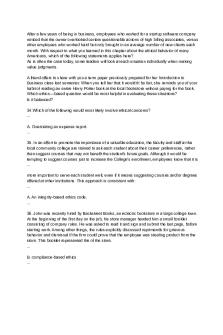Chapter 10 Notes - Professor James Smolin, Ph.D. PDF

| Title | Chapter 10 Notes - Professor James Smolin, Ph.D. |
|---|---|
| Course | Abnormal Psychology |
| Institution | Orange Coast College |
| Pages | 6 |
| File Size | 567 KB |
| File Type | |
| Total Downloads | 3 |
| Total Views | 144 |
Summary
Professor James Smolin, Ph.D....
Description
Chapter 10 Notes Substance-Related and Other Addictive Disorders
substance abuse pattern of excessive or harmful use of any substance for mood-altering purposes (noninterfering) substance-use disorder a condition in which cognitive, behavioral, and physiological symptoms contribute to the continued use of alcohol or drugs despite significant substance-related problems (2 characteristics for 12 month period) Interference; tolerance; withdrawal; seeking (similar to a gambling addiction)
psychoactive substance a substance that alters mood, thought processes, or other psychological states intoxication a condition involving problem behaviors or psychological changes that occur with excessive substance use (impairment) addiction compulsive drug-seeking behavior and a loss of control over drug use withdrawal the adverse physical and psychological symptoms that occur after reducing or ceasing intake of a substance physiological dependence a state of adaptation that occurs after chronic exposure to a substance; can result in craving and withdrawal symptoms
Neuroplasticity (reorganize, adapt) “drug” brain ADH (alcohol dehydrogenase Opponent Process Theory Effects: dementia (Wernicke-Korsakoff; related to thiamine processing) tolerance decreases in the effects of a substance that occur after chronic use depressant a substance that causes a slowing of responses and generalized depression of the central nervous system moderate drinking a lower-risk pattern of alcohol intake (no more than one or two drinks per day) heavy drinking chronic alcohol intake of more than two drinks per day for men & more than one drink per day for women
binge drinking episodic intake of five or more alcoholic beverages for men or four or more drinks for women alcohol poisoning toxic effects resulting from rapidly consuming alcohol or ingesting a large quantity of alcohol; can result in impaired breathing, coma, and death alcoholism a condition in which the individual is dependent on alcohol and has difficulty controlling drinking abstinence restraint from the use of alcohol, drugs, or other addictive substances
opioid a painkilling agent that depresses the central nervous system, such as heroin & prescription pain relievers gateway drug a substance that leads to the use of additional substances that are even more lethal sedatives a class of drugs that have a calming or sedating effect hypnotics a class of medications that induce sleep anxiolytics a class of medications that reduce anxiety stimulant a substance that energizes the central nervous system hallucinogen a substance that induces perceptual distortions and heightens sensory awareness dissociative anesthetic a substance that produces a dreamlike detachment hyperthermia significantly elevated body temperature behavioral undercontrol a personality trait associated w rebelliousness, novelty seeking, risk taking, impulsivity detoxification the phase of alcohol or drug treatment during which the body is purged of intoxicating substances relapse a return to drug or alcohol use after a period of abstinence neuroplasticity the ability of the brain to change its structure and function in response to experience
motivational enhancement therapy a therapeutic approach that addresses ambivalence and helps clients consider the advantages and disadvantages of changing their behavior controlled drinking consuming no more than a predetermined amount of alcohol Current users (U.S.): >50% use alcohol Binges: @25% College students (D & F students are 4x more likely vs. A students) – 45.51% binge drinking
Agonist substitution – replacement therapy like nicotine patch Antagonist – Supplemental therapy like Opiates; methadone Aversive – need compliance Key Terms substance abuse 262 substance-use disorder 262 psychoactive substance 262 intoxication 262 addiction 262 withdrawal 262 physiological dependence 262 tolerance 263 depressant 264 moderate drinking 265 heavy drinking 265 binge drinking 265 alcohol poisoning 267 alcoholism 267 abstinence 267 opioid 268 gateway drug 268 sedatives 269
hypnotics 269 anxiolytics 269 stimulant 269 hallucinogen 271 dissociative anesthetic 272 hyperthermia 272 behavioral undercontrol 279 detoxification 285 relapse 285 neuroplasticity 285 motivational enhancement therapy 285 controlled drinking 286...
Similar Free PDFs

M8 - Professor: James Kahl
- 2 Pages

T8 - Professor: James Grecco
- 3 Pages

M5 - Professor: James Kahl
- 3 Pages

B4 - Professor: Terry James
- 2 Pages

M16 - Professor: James Kahl
- 2 Pages

M12 - Professor: James Kahl
- 2 Pages

T15 - Professor: James Grecco
- 2 Pages

B5 - Professor: Terry James
- 2 Pages

T16 - Professor: James Grecco
- 4 Pages

T3 - Professor: James Grecco
- 2 Pages

M3 - Professor: James Kahl
- 2 Pages

Notes 10 - Chapter 10
- 5 Pages
Popular Institutions
- Tinajero National High School - Annex
- Politeknik Caltex Riau
- Yokohama City University
- SGT University
- University of Al-Qadisiyah
- Divine Word College of Vigan
- Techniek College Rotterdam
- Universidade de Santiago
- Universiti Teknologi MARA Cawangan Johor Kampus Pasir Gudang
- Poltekkes Kemenkes Yogyakarta
- Baguio City National High School
- Colegio san marcos
- preparatoria uno
- Centro de Bachillerato Tecnológico Industrial y de Servicios No. 107
- Dalian Maritime University
- Quang Trung Secondary School
- Colegio Tecnológico en Informática
- Corporación Regional de Educación Superior
- Grupo CEDVA
- Dar Al Uloom University
- Centro de Estudios Preuniversitarios de la Universidad Nacional de Ingeniería
- 上智大学
- Aakash International School, Nuna Majara
- San Felipe Neri Catholic School
- Kang Chiao International School - New Taipei City
- Misamis Occidental National High School
- Institución Educativa Escuela Normal Juan Ladrilleros
- Kolehiyo ng Pantukan
- Batanes State College
- Instituto Continental
- Sekolah Menengah Kejuruan Kesehatan Kaltara (Tarakan)
- Colegio de La Inmaculada Concepcion - Cebu



